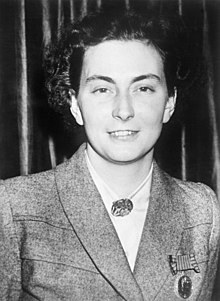| Belgian Resistance | |||||||
|---|---|---|---|---|---|---|---|
| Part of Resistance during World War II | |||||||
 Andrée de Jongh, head of the Comet Line, receiving the George Medal in 1946 | |||||||
| |||||||

The helpers gambled their homes—even the lives of their families—to help the airmen escape, and many of them lost ... it is not difficult to understand that over 50 years later tributes are still paid to the World War II helpers, and enormous gratitude still remains with each of the airmen saved by these heroic people.[1]
The Comet Line (French: Réseau Comète; 1941–1944) was a Resistance organization in occupied Belgium and France in the Second World War. The Comet Line helped Allied soldiers and airmen shot down over occupied Belgium evade capture by Germans and return to Great Britain. The Comet Line began in Brussels where the airmen were fed, clothed, given false identity papers, and hidden in attics, cellars, and people's homes. A network of volunteers then escorted them south through occupied France into neutral Spain and home via British-controlled Gibraltar. The motto of the Comet Line was "Pugna Quin Percutias", which means "fight without arms", as the organization did not undertake armed or violent resistance to the German occupation.[2]
The Comet Line was the largest of several escape networks in occupied Europe. In three years, the Comet Line helped 776 people, mostly British and American airmen, escape to Spain or evade capture in Belgium and France.[3] An estimated 3,000 civilians, mostly Belgians and French, assisted the Comet Line. They are usually called "helpers". Seven hundred helpers were arrested by the Germans and 290 were executed or died in prison or concentration camps.[4] The Comet Line maintained its operational independence, but received financial assistance from MI9, a British intelligence agency dedicated to the rescue of Allied prisoners of war and service members from behind enemy lines.
For the Allies, the rescue of downed airmen by the Comet and other escape lines had a practical as well as a humanitarian objective. Training new and replacement air crews was expensive and time-consuming. Rescuing airmen downed in occupied Europe and returning them to duty was a priority. Andrée de Jongh (code named "Dédée"), a 24-year-old Belgian woman, was the first leader of the Comet Line. She was imprisoned by the Germans in 1943, but survived the war. Subsequent leaders were also imprisoned, executed, or killed in the course of their work getting airmen to Spain. Young women, including teenagers, played important roles in the Comet Line. Sixty-five to 70 percent of Comet Line helpers were women.[5]
- ^ Ottis 2001, p. 43.
- ^ "207 Squadron Royal Air Force" accessed 19 Oct 2019
- ^ Rossiter 1986, p. 31.
- ^ "Cométe", San Telmo Museao, accessed 27 Sep 2019
- ^ Rossiter 1986, p. 24.